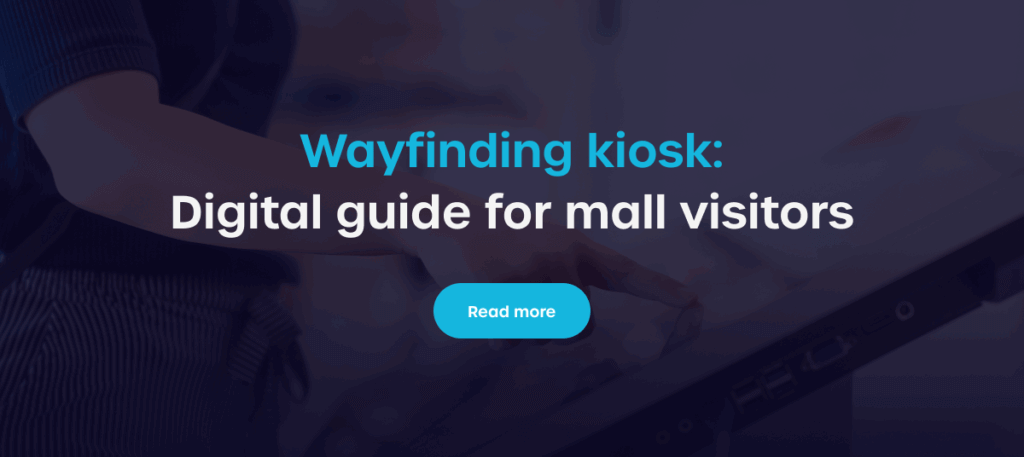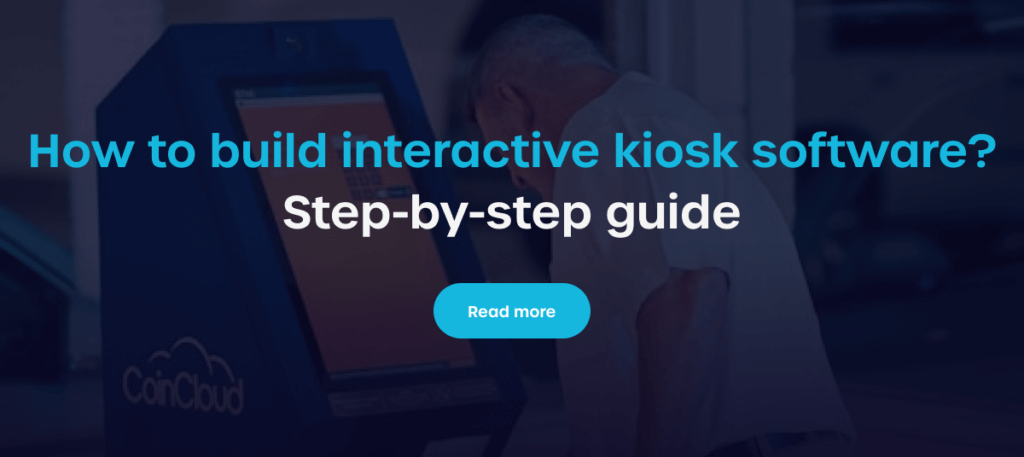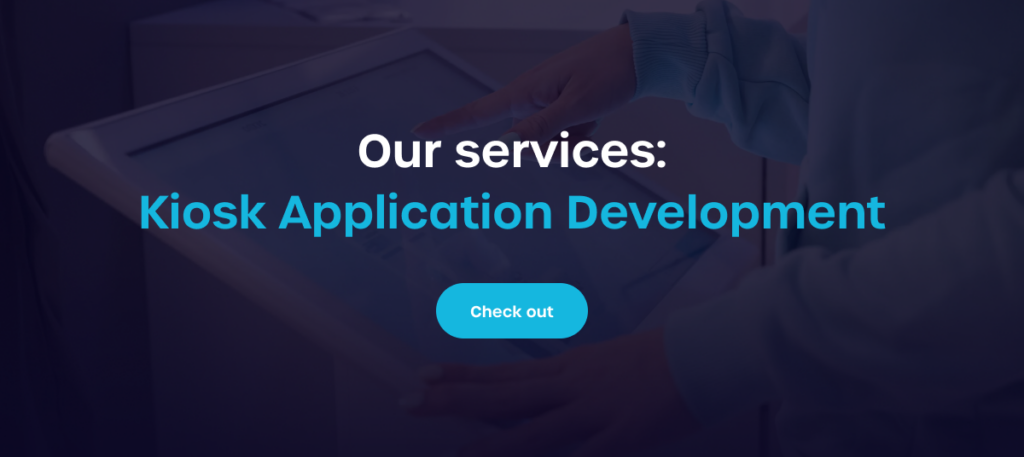Each year, about 75% of adult Americans – which is roughly 184 million people – visit a regional or super‑regional shopping mall at least once per quarter, averaging 4.2 visits over that period. In this context, mall wayfinding systems are increasingly vital to enhance navigation, reduce shopper frustration, and elevate the overall shopping experience.
The cost of a shopping center wayfinding kiosk depends on several factors, including screen type, custom enclosures, and the number of units deployed. Software customization, integrations, and multilingual support can also increase development time and pricing. Additionally, factors like data quality, mall size, and service-level expectations significantly influence the final cost. This article does not list specific price figures; instead it explores the key factors that influence cost and explains why the final investment always depends on the client’s unique requirements.
Hardware and system environment impact on mall wayfinding kiosks
The deployment of wayfinder is significantly influenced by the hardware and system environment in which they operate. Factors such as custom hardware requirements and the number of deployed devices must be effectively managed to enhance user experience and functionality.
Custom hardware requirements for mall wayfinding system
Mall wayfinding kiosks typically require industrial-grade components built for continuous use in high-traffic environments. This includes high-brightness touchscreens, vandal-resistant enclosures, and reliable internal hardware like media players and cooling systems.
If a client opts for non-standard or lower-performance hardware instead of the recommended setup, additional costs may arise due to the need for software optimization and testing tailored to those specific devices. Integrating peripheral components like NFC readers, barcode scanners, or printers can also raise both hardware and development costs.
Unusual screen sizes or resolutions
Unusual screen sizes or non-standard resolutions are sometimes chosen in mall wayfinding to match architectural constraints or achieve stronger visual impact. While they can improve user experience, they often increase overall cost due to custom software scaling and limited hardware availability. Supporting such displays may also require additional design and testing work.
Cost drivers include:
- Custom UI scaling and layout adjustments for non-standard resolutions.
- Limited vendor options for irregular screen dimensions.
- Increased testing time to ensure visual consistency across devices.
Operating system changes in mall wayfinding kiosk
The operating system used in a mall wayfinding kiosk directly impacts performance, compatibility, and maintenance requirements. Switching from a standard Android setup to a custom Linux distribution, for example, may be required to support advanced integrations or tighter system control.
However, such changes can significantly raise development costs due to driver compatibility issues, custom kernel configurations, or the need for dedicated security hardening. Ensuring long-term support and OTA (over-the-air) update capabilities also adds to the complexity.
Number of deployed devices
The number of deployed mall wayfinding kiosks directly impacts both cost and system architecture:
- Hardware volume discounts – Larger deployments can reduce unit pricing but increase upfront investment.
- Infrastructure planning – More kiosks require careful coordination of power, network, and mounting points across the site.
- Centralized content management – A higher number of devices demands robust backend systems for remote updates, monitoring, and analytics.
- Maintenance and support – More units lead to increased servicing needs, SLA complexity, and spare parts logistics.

Software customization and technical complexity
Software customization significantly impacts both the functionality and cost of mall wayfinding kiosks. Adapting the system to specific branding, navigation logic, or third-party integrations often requires detailed planning and additional development effort. The more tailored the solution, the higher the complexity and total project cost.
Custom UI and branding for mall wayfinding kiosks
Creating a custom user interface and incorporating branding into shopping center wayfinding kiosks helps deliver a consistent and professional shopping experience. When a kiosk reflects the mall’s visual identity through logos, color schemes, typography, and tone of voice, it reinforces brand recognition and builds trust with users.
This familiarity makes the interface more intuitive and encourages repeated use. While such customization is important for aligning with the mall’s overall branding strategy, it often increases development time and cost due to the need for tailored design work, user testing, and precise implementation across multiple devices.
Non-standard functionalities
Adding non-standard functionalities to mall wayfinding kiosks can enhance user engagement and offer added value beyond basic navigation. These advanced features often require custom integrations, which can increase both development time and cost.
- Real-time store inventory display – Allows shoppers to check product availability before entering a store.
- Dynamic promotion banners – Displays time-sensitive offers or mall-wide events based on user location or time of day.
- Queue management integration – Enables visitors to join virtual lines for services like salon appointments or food court seating.
- Wayfinding to parked cars – Guides users back to their vehicle using parking zone input or license plate recognition.
- Augmented reality overlays – Offers interactive directions or gamified mall experiences through visual overlays.


Integration with external services
Integration with external services adds valuable functionality to mall wayfinding kiosks and enables real-time, personalized content through connections with mobile apps, websites, or third-party APIs.
- Mobile app synchronization – Lets users transfer directions from kiosk to phone.
- Live event feeds – Pulls real-time updates for mall events, workshops, or pop-ups.
- Parking availability data – Displays current open spaces from the parking system.
- Loyalty program access – Connects to user accounts to show rewards or personalized deals.
- Public transit integration – Shows live departure times and walking directions to nearby stations.
Each additional integration increases development effort, testing, and long-term support needs, which raises the overall cost. Malls that choose fewer or simpler integrations can reduce technical complexity and keep the project more affordable.
Multilingual support
In a diverse shopping environment, multilingual support for mall wayfinding kiosks improves accessibility and enhances the overall visitor experience. It allows international tourists and non-native speakers to navigate the mall confidently and find relevant information without confusion. This inclusivity can increase user satisfaction and encourage longer visits.
However, supporting multiple languages requires additional content preparation, translations, and interface adjustments for each version. The more languages implemented, the more development, testing, and maintenance work is needed, which directly impacts the overall cost.

Project-specific requirements for mall wayfinding systems
Tailored project-specific requirements are vital for the successful deployment of mall wayfinding systems. These requirements govern the overall functionality and performance, ensuring that each kiosk meets the mall's unique navigation needs.
Quality of provided data
The effectiveness of mall wayfinding kiosks largely depends on the quality of the underlying data. Accurate and up-to-date information about store locations, amenities, and services is essential for delivering reliable navigation and a smooth user experience.
When the provided data is well-structured, complete, and consistent, it reduces the need for manual corrections, data cleaning, or system-level adjustments. This significantly shortens implementation time and helps lower development costs. Poor or incomplete data, on the other hand, often leads to additional work and delays.
Size and structure of the mall
The size and architecture of a mall directly influence the design, quantity, and placement of wayfinding kiosks. Larger or more complex malls require more kiosks to provide full coverage and ensure easy navigation for all visitors. As the mall size increases, so do the time and costs associated with setup.
This is due to the need for more detailed maps, a greater volume of location data, longer routing logic, and additional effort to organize and validate all content across multiple zones or floors. Complex layouts may also demand more customized UI flows and testing scenarios.
SLA and ongoing maintenance
A well-defined Service Level Agreement (SLA) ensures that mall wayfinding kiosks remain reliable, secure, and consistently available to users. Ongoing maintenance plays a key role in minimizing disruptions and preserving long-term system performance:
- Guaranteed uptime – Commitments to keeping kiosks operational for a specified percentage of time (e.g. 99.5%).
- Regular software updates – Scheduled improvements, bug fixes, and security patches.
- Remote monitoring – Continuous system health checks with alerts for any malfunctions.
- On-site support – Defined response times for hardware repairs or physical maintenance.
- Content updates – Routine updates to store directories, promotions, or mall layouts.
Stronger SLA terms and more frequent maintenance services increase operational stability but also raise long-term costs.
Advanced analytics features
Utilizing advanced analytics features can provide valuable insights into how mall wayfinding kiosks are used. By tracking shopper interactions, malls can better understand visitor behavior, optimize layouts, and improve the overall experience.
Examples of paid analytics features:
- Heatmaps – Visualize the most frequently used kiosk areas or screen elements.
- Path tracking – Analyze common navigation routes taken by visitors.
- Session recordings – Review anonymized user interactions to identify pain points.
- Conversion tracking – Measure actions like QR code scans or coupon downloads.
- Custom dashboards – Provide mall managers with real-time usage statistics and reports.

Compliance, scalability, and project management
Navigating compliance, scalability, and effective project management is essential for the successful implementation of mall wayfinding kiosks. As the requirements of a project evolve, adaptability becomes key to maintaining effectiveness and meeting user needs.
Changing requirements mid-project
When requirements change during the project, the wayfinding system needs to adapt accordingly. This flexibility helps ensure the final product meets the mall's updated goals and shopper expectations. For example, if a decision is made mid-project to support an additional language or integrate a new loyalty program, it may require redesigning parts of the user interface and modifying the backend. Such changes often lead to additional development time, testing, and increased costs.
Compliance and security standards
Adhering to compliance and security standards is essential when deploying mall wayfinding kiosks. It ensures that user data is handled responsibly and that the system aligns with legal and industry-specific regulations. Depending on the project scope, this may include:
- GDPR compliance – Required when collecting or processing personal data from users in the EU, even if only for feedback forms or loyalty logins.
- PCI DSS compliance – Necessary if the kiosk includes payment functionality, such as ticketing or gift card purchases.
- Penetration testing and security audits – Often mandated for systems connected to public networks or handling user input.
- Data encryption and secure API communication – Protects sensitive information exchanged between the kiosk and backend services.
Meeting these standards helps protect users and the mall operator but often requires extra development time, security expertise, and ongoing compliance reviews.
Detailed documentation and testing
Comprehensive documentation and rigorous testing are essential to ensure that mall wayfinding kiosks function reliably and meet all project requirements. These steps reduce the risk of post-launch issues and support long-term system maintenance.
Key areas include:
- Technical documentation – Covers system architecture, hardware specifications, API references, and integration guidelines for future scalability.
- Functional and usability testing – Verifies that navigation flows, touch responses, and language switching work smoothly across all devices.
- Edge case and failover testing – Ensures the system handles unexpected inputs, offline scenarios, or partial data loss without crashing.
Accessibility expectations for mall wayfinding kiosks
Accessibility is a critical requirement for mall wayfinding kiosks, ensuring that all visitors — including those with visual, auditory, or mobility impairments — can use the system effectively. To meet this expectation, kiosks should follow standards such as the Americans with Disabilities Act (ADA) and the Web Content Accessibility Guidelines (WCAG 2.1).
This includes implementing features like screen readers or text-to-speech functionality, tactile keypads or braille labels, high-contrast UI design, adjustable text sizes, and proper screen height for wheelchair access. Compliance with these standards not only promotes inclusivity but also reduces legal risks. However, designing and testing for accessibility adds development complexity and increases overall project cost.

FAQ - Mall wayfinding
How much does a mall wayfinding kiosk cost?
The cost of a mall wayfinding kiosk can vary widely based on features, hardware, and software customization. On average, businesses should expect to invest anywhere from a few thousand to tens of thousands of dollars for a fully functional system.
What affects the price of an interactive wayfinding kiosk?
Here are the aspects that affect the price of the kiosk:
- Hardware and system environment impact on mall wayfinding kiosks – The choice of hardware, screen type, operating system, and number of devices directly affects both upfront and long-term costs.
- Software customization and technical complexity – The level of UI customization, added features, integrations, and language support significantly increases development time and budget.
- Project-specific requirements for mall wayfinding systems – Factors like mall size, data quality, analytics needs, and service agreements influence both implementation and maintenance costs.
- Compliance, scalability, and project management – Adapting to changing requirements, meeting legal standards, and ensuring accessibility and scalability all contribute to increased complexity and overall price.
Can I use my own hardware with a wayfinding kiosk system?
Yes, you can use your own hardware with a wayfinding kiosk system, but it often results in higher overall costs. Customizing the software to match non-recommended or lower-performance devices may require additional development, testing, and optimization to ensure full compatibility and stable performance.
Is it more expensive to have a custom design for a wayfinding kiosk?
A custom design for a wayfinding kiosk may entail higher initial costs but offers the advantage of a tailored user experience. This investment often pays off in enhanced user engagement and satisfaction in a shopping centre setting, making it a worthwhile consideration.
Do mall kiosk systems include support and maintenance in the price?
Support and maintenance are often included in the price of mall wayfinding kiosk systems, but it's essential to review the terms thoroughly. Understanding these aspects ensures that the kiosks will remain functional and up-to-date, providing ongoing support for both shoppers and mall operators.







